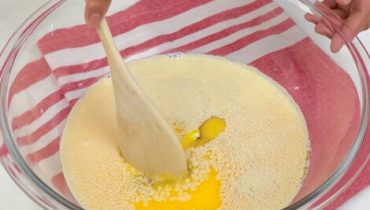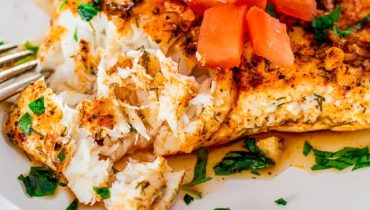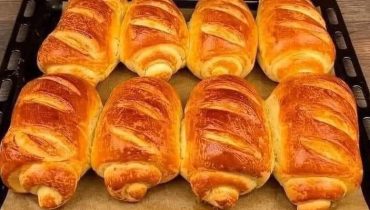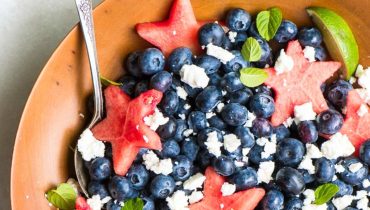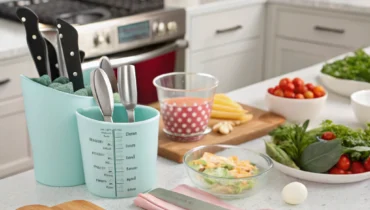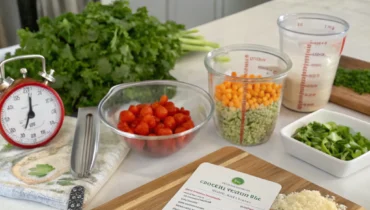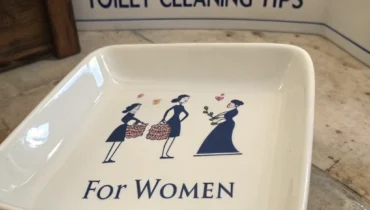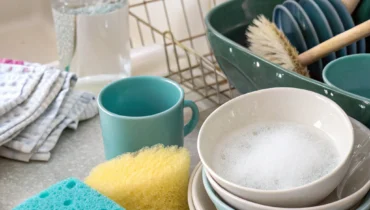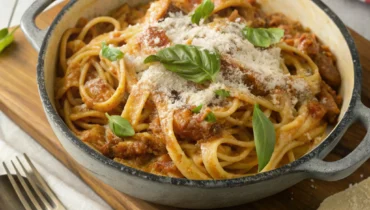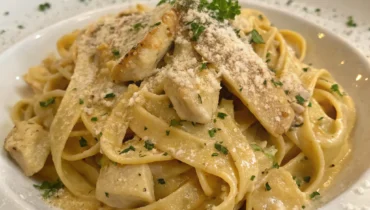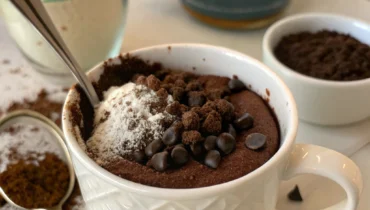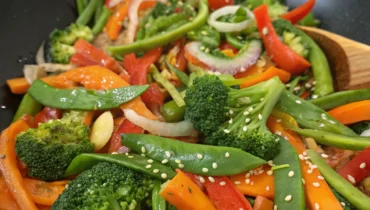How to Make Scones
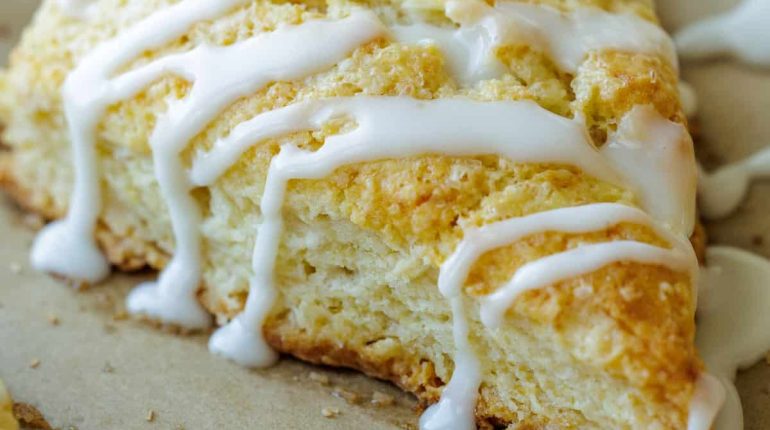
Posted November 3, 2023 by: Admin
This deliciously moist and flaky Scones Recipe is the base for a variety of perfect, homemade scones. Once you know how to make classic scones, you can come up with a hundred flavor variations.
We love homemade pastry recipes from our classic Apple Turnovers to the famous Baklava. If you’re also a fan of delicious pastries, this classic Scone recipe is a must-try!
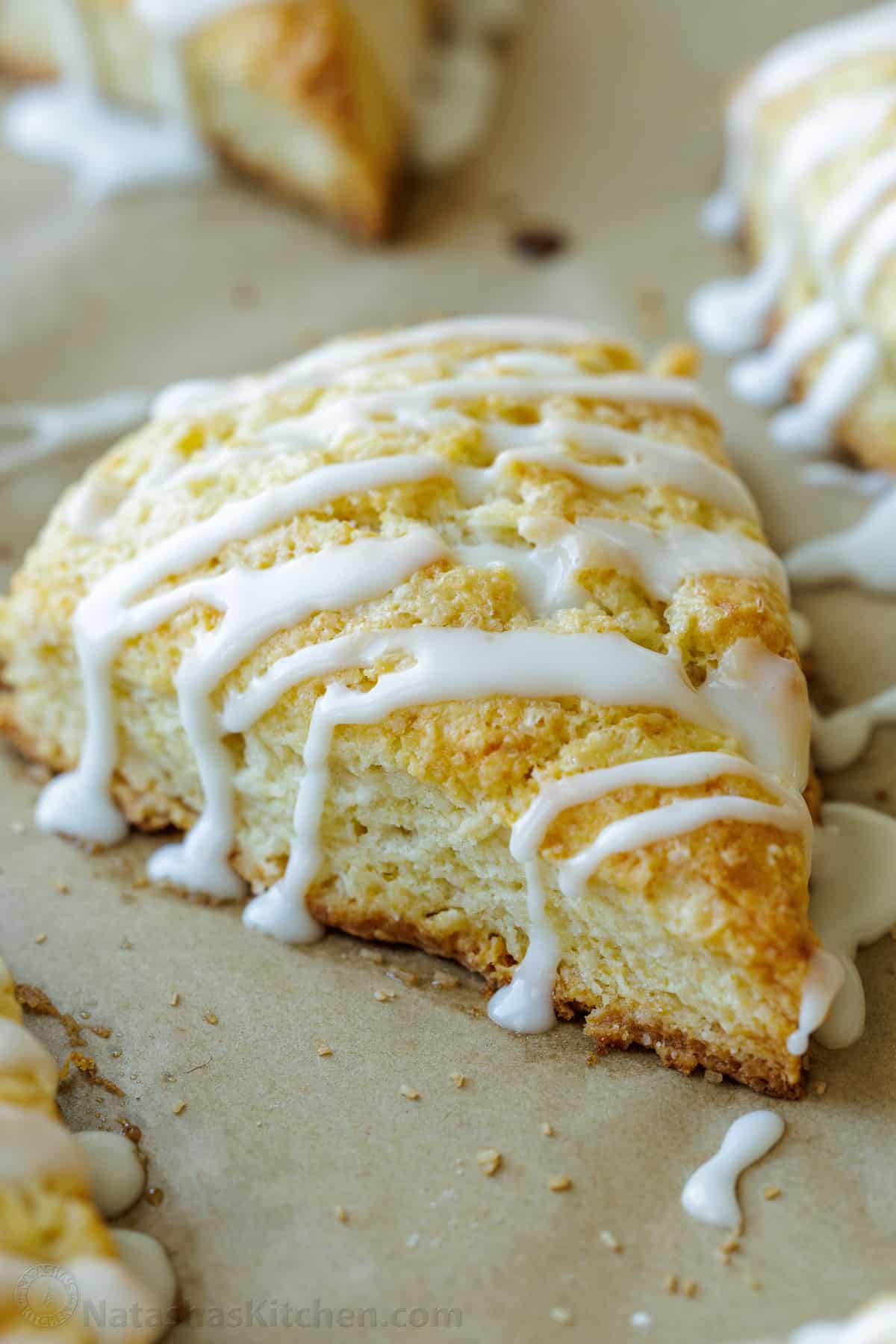
Best Scone Recipe
Scones can be served for breakfast or brunch, at an elegant afternoon tea (bridal or baby showers come to mind), or at a cozy gathering with family or friends. With so many flavor options- from blueberries, chocolate chips, or lemon zest- they are a perfect treat. Here’s why you’ll love this scone recipe:
- Customizable – It can be easily made with your favorite ingredients to suit your taste.
- Make-Ahead – The recipe can be made ahead of time and frozen (see instructions below).
- Texture perfection – Moist inside with a touch of crisp on the outside.
What are Scones?
Scones originated in the United Kingdom. They are considered a quick bread, often shaped into circles similar to a Southern biscuit, or wedges. Though they have similar ingredients as biscuits – a foundation of flour, butter, heavy cream (or buttermilk), and a leavening agent to help them rise – the proportions and resulting textures are completely different.
English “scones” are closely related to American “Biscuits” – they are less sweet and are served with Devonshire cream or clotted cream and jam. American scone recipes like this one, tend to have more butter, heavy cream, and sugar in the recipe and often have mix-ins added.
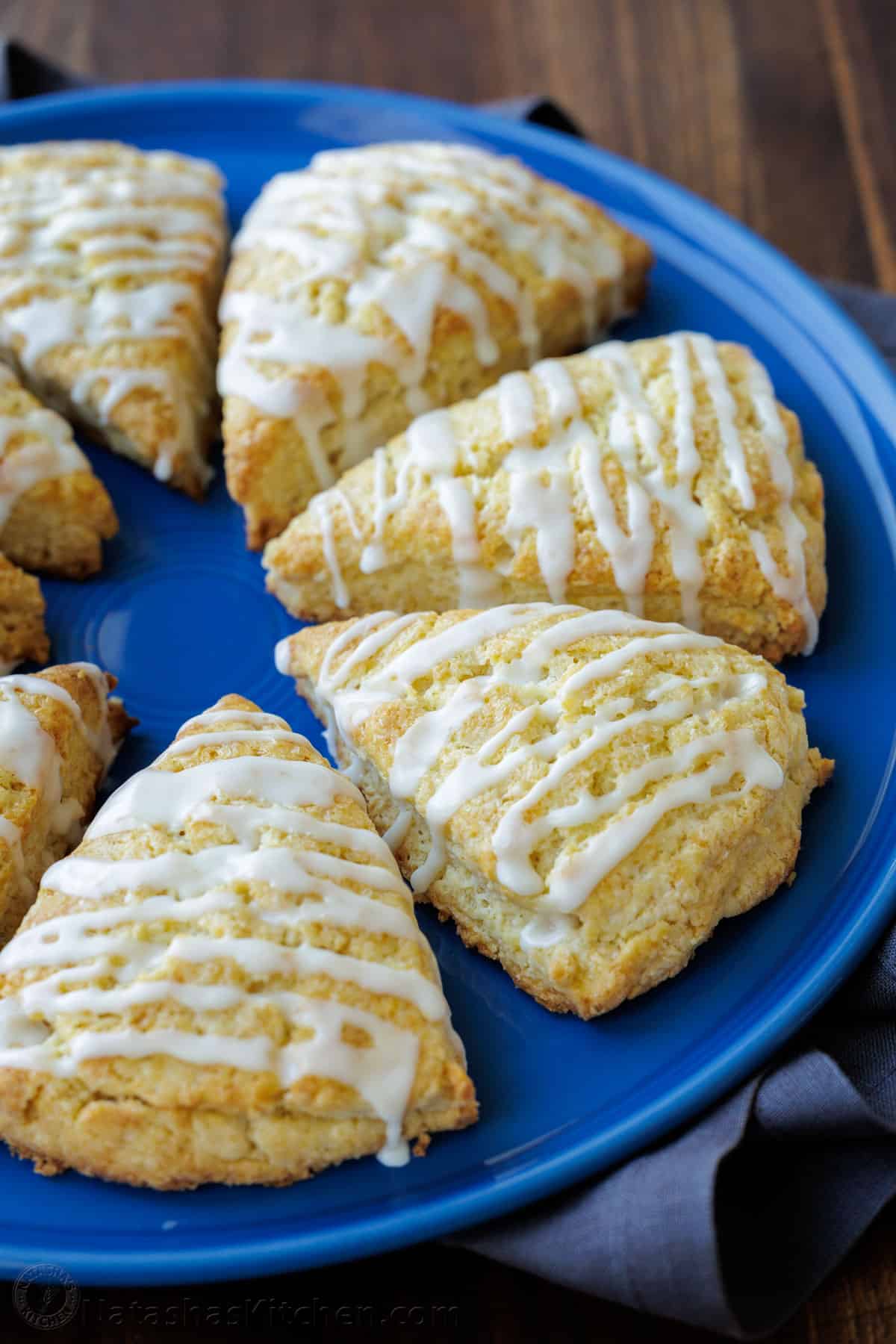
Tips for Making the Best Scones
The key to making fluffy and flaky scones is to use cold ingredients and keep them cold. If you use room-temperature ingredients or handle the dough too much, your dough will over-spread in the oven, leaving you with flat scones instead of the tall, moist, and flaky scones you dream about.
- Cold Ingredients – Keep all of your ingredients refrigerated and very cold until ready to use.
- Dice butter ahead of time and then return it to the refrigerator until it is time to add it to the recipe.
- Chill before baking – Refrigerate your formed dough for at least 15 minutes before baking.
- Cut straight down with a food scraper or knife and avoid using a sawing motion.
- Fully preheat the oven – a hot oven turns the butter into steamy air pockets and prevents butter from pooling in the pan. An oven thermometer helps!
Ingredients for Scones
See the list below (full measurements in the recipe card) for my tried and true scone recipe.
- Flour – All-purpose works great
- Sugar – lightly sweetens the dough
- Baking powder – makes the dough rise
- Salt – balances the flavors
- Butter – unsalted (make sure it’s cold)
- Egg – adds structure and flavor
- Heavy cream – cold cream provides moisture for a rich texture and soft crumb; also used to brush the tops
- Vanilla extract – try real or homemade vanilla for the best flavor
- Raw sugar – to sprinkle over scones
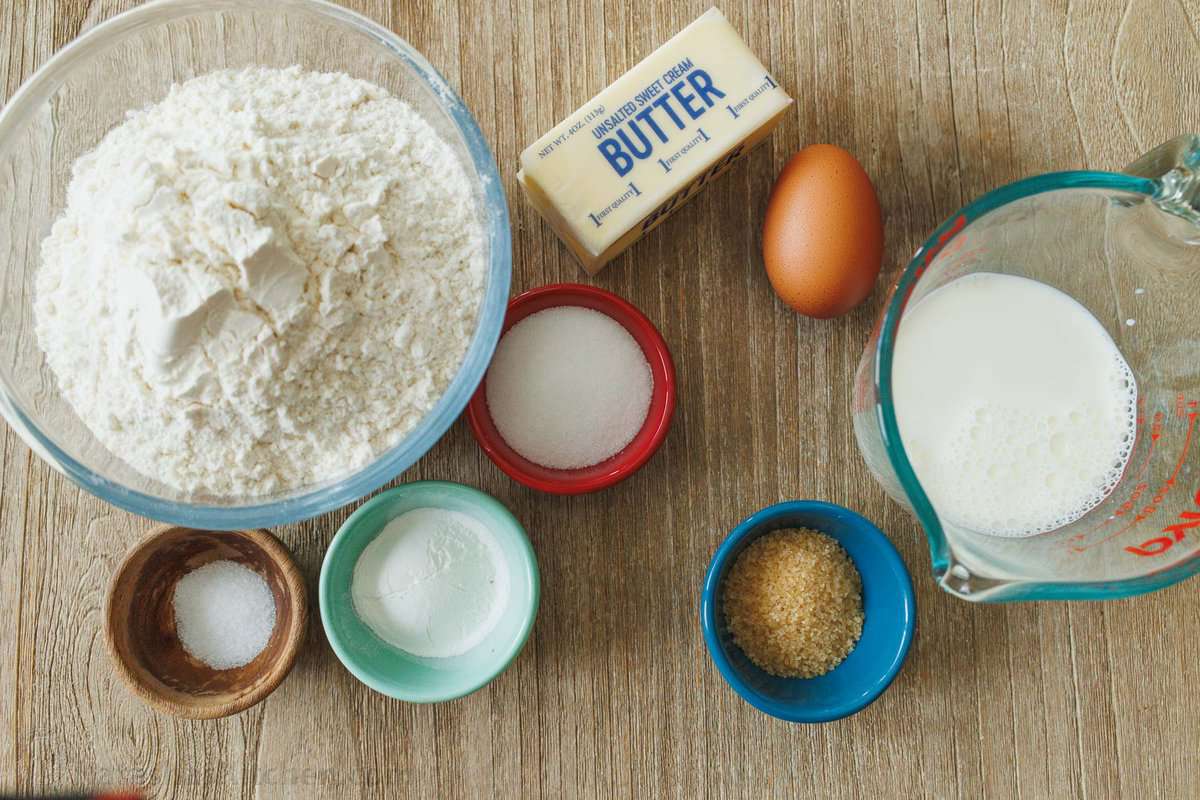
Optional Vanilla Glaze
- Milk – any kind, even a dairy-free milk. Add more milk to thin the glaze.
- Powdered sugar – Add more powdered sugar to thicken the glaze.
- Vanilla – Use real vanilla extract
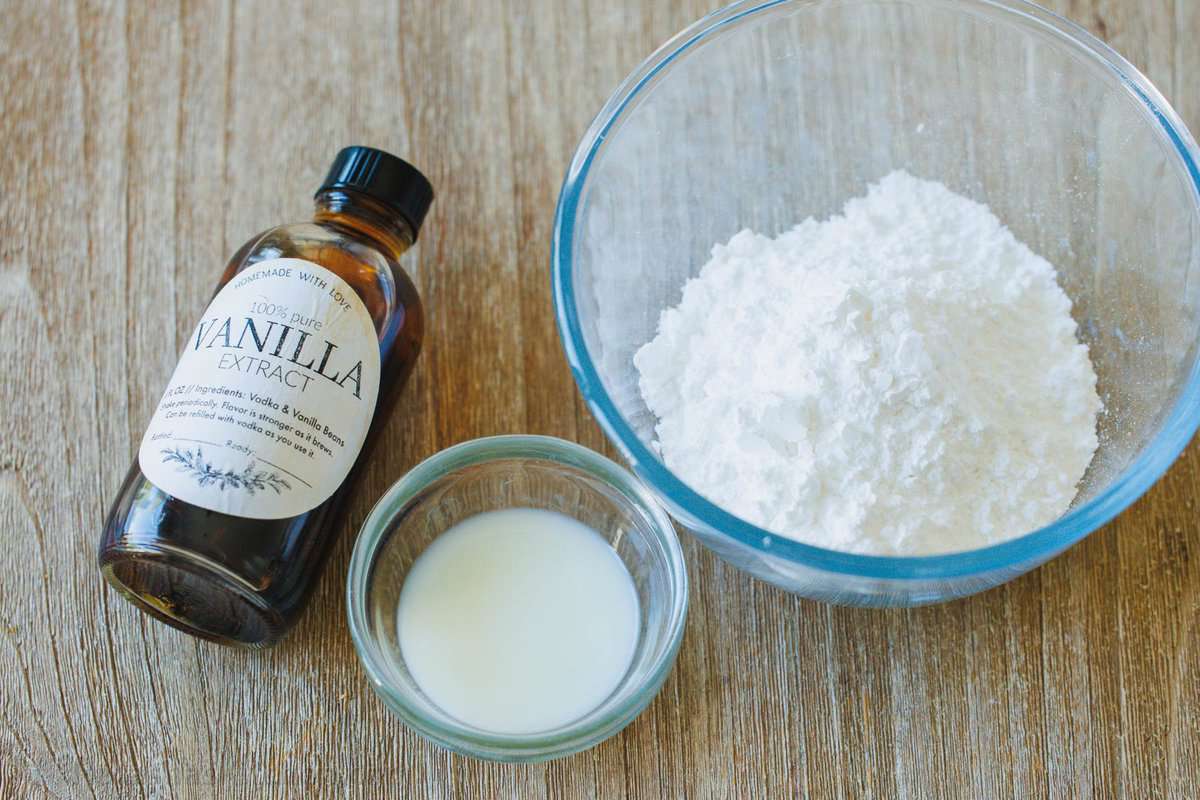
Variations
We recommend adding 1 to 1 1/4 cups of add-ins. Adding too much fruit may cause your scones to fall apart. We recommend the following varieties, but get creative and add in your favorites!
- Blueberry Scones
- Chocolate Chip Scones – Use mini chocolate chips
- Raspberry and White Chocolate Chip Scones
- Blackberry Scones
- Cranberry Orange Scones
- Strawberry Scones
- Cinnamon Sugar Scones – sprinkle with 1 Tbsp sugar and 1/2 tsp cinnamon before baking.
- Savory Scones – Reduce your sugar to 2 Tbsp and omit vanilla. Add 1 cup of shredded cheese (cheddar or parmesan), herbs (rosemary, thyme, chives), and cooked, bite-sized pieces of meat such as bacon or ham.
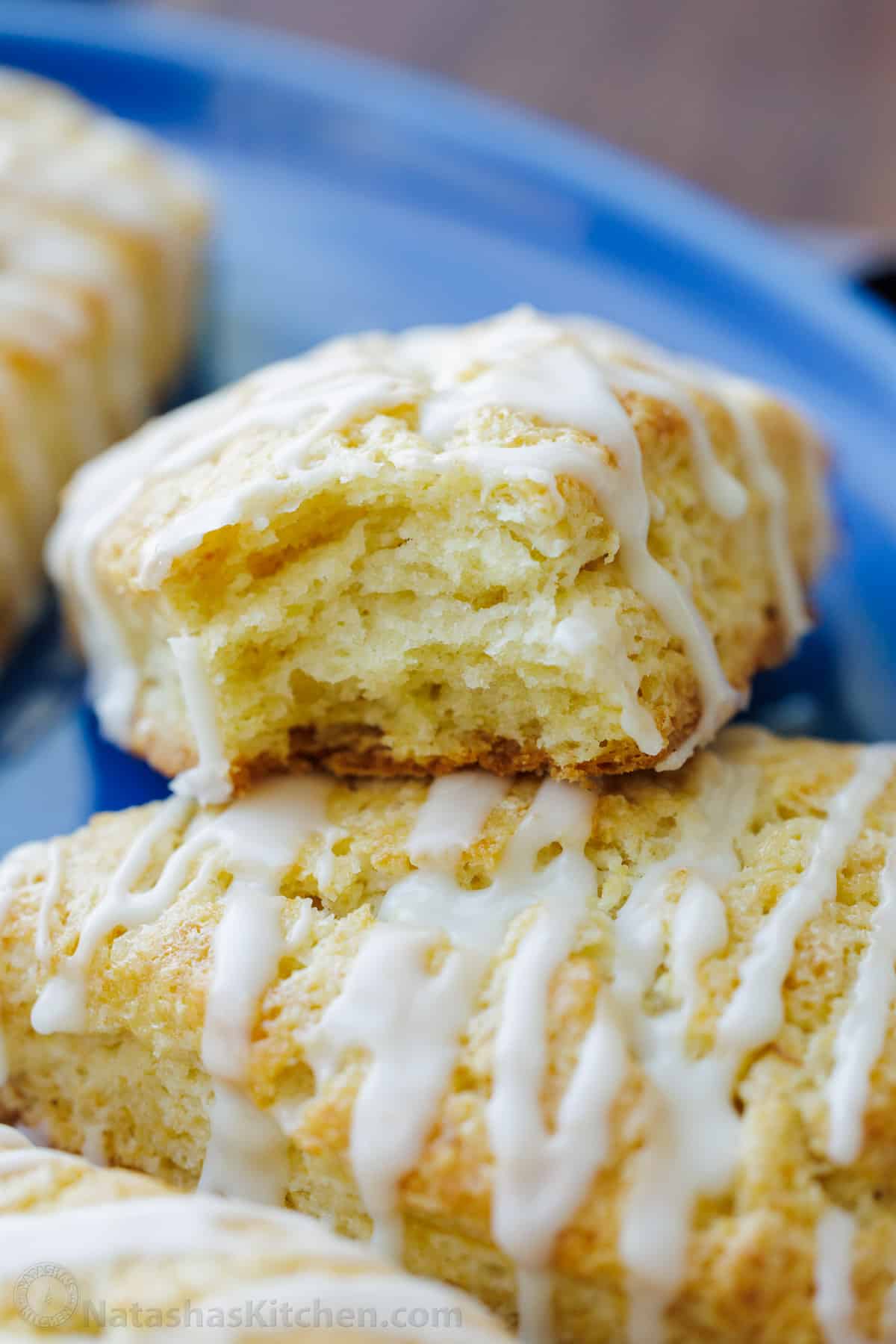
How to Make the Perfect Scones
- Prep – Preheat the oven to 400°F and line a baking sheet with parchment paper.
- Dry Ingredients – In a large mixing bowl, whisk together flour, sugar, baking powder and salt. Add cold unsalted butter and cut it into the flour mixture with a pastry blender until pea-sized crumbs form. Gently fold in flavor add-ins if using. Refrigerate while preparing wet ingredients.
- Wet Ingredients – In a small bowl, combine cream, eggs, and vanilla. Beat with a fork until well blended. Combine the cream mixture and flour mixture and fold with a spatula until moistened.
- Work the Dough – Transfer the dough onto a clean, lightly floured surface and work it into a ball of dough just until it comes together. Next, flatten into a 1-inch thick and 7-inch wide disk. Chop into 8 equal wedges.
- Chill – Arrange scones on a lined baking sheet 1 inch apart. Brush the tops with cream and generously sprinkle with coarse sugar. Refrigerate for 15 minutes before baking.
- Bake – Bake for 20-23 minutes. Remove from the oven and cool completely. Drizzle with glaze if desired.
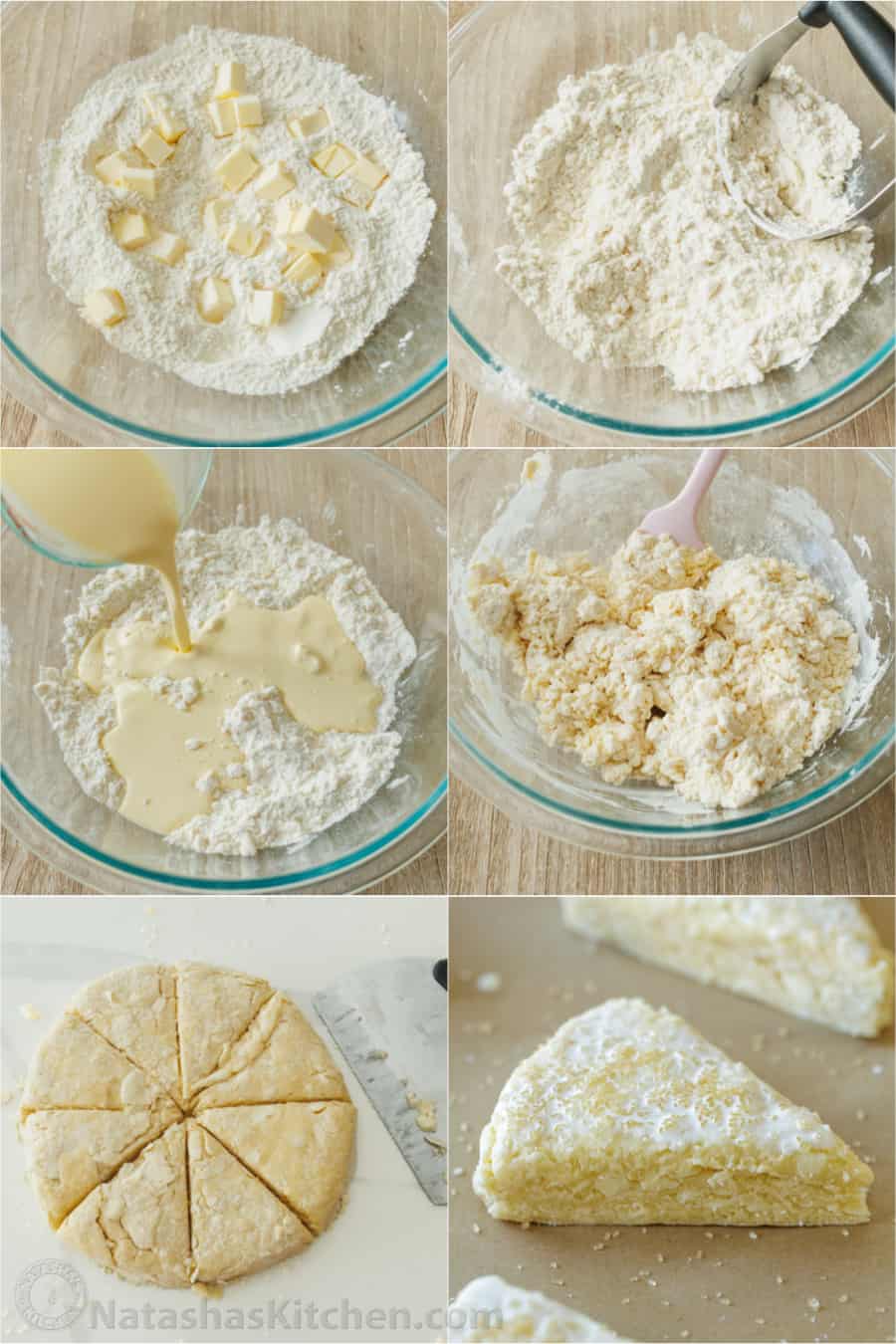
Pro Tip:
The scones are done when the tops are golden and the edges golden brown. The internal temperature on an instant-read thermometer should register at 200°F when done.
How to Make Vanilla Glaze
In a small bowl, combine powdered sugar, milk, and vanilla. Stir until well blended. The glaze should be drizzling consistency; add powdered sugar to thicken or milk to thin the glaze. Using a spoon, drizzle the glaze over the cooled scones.
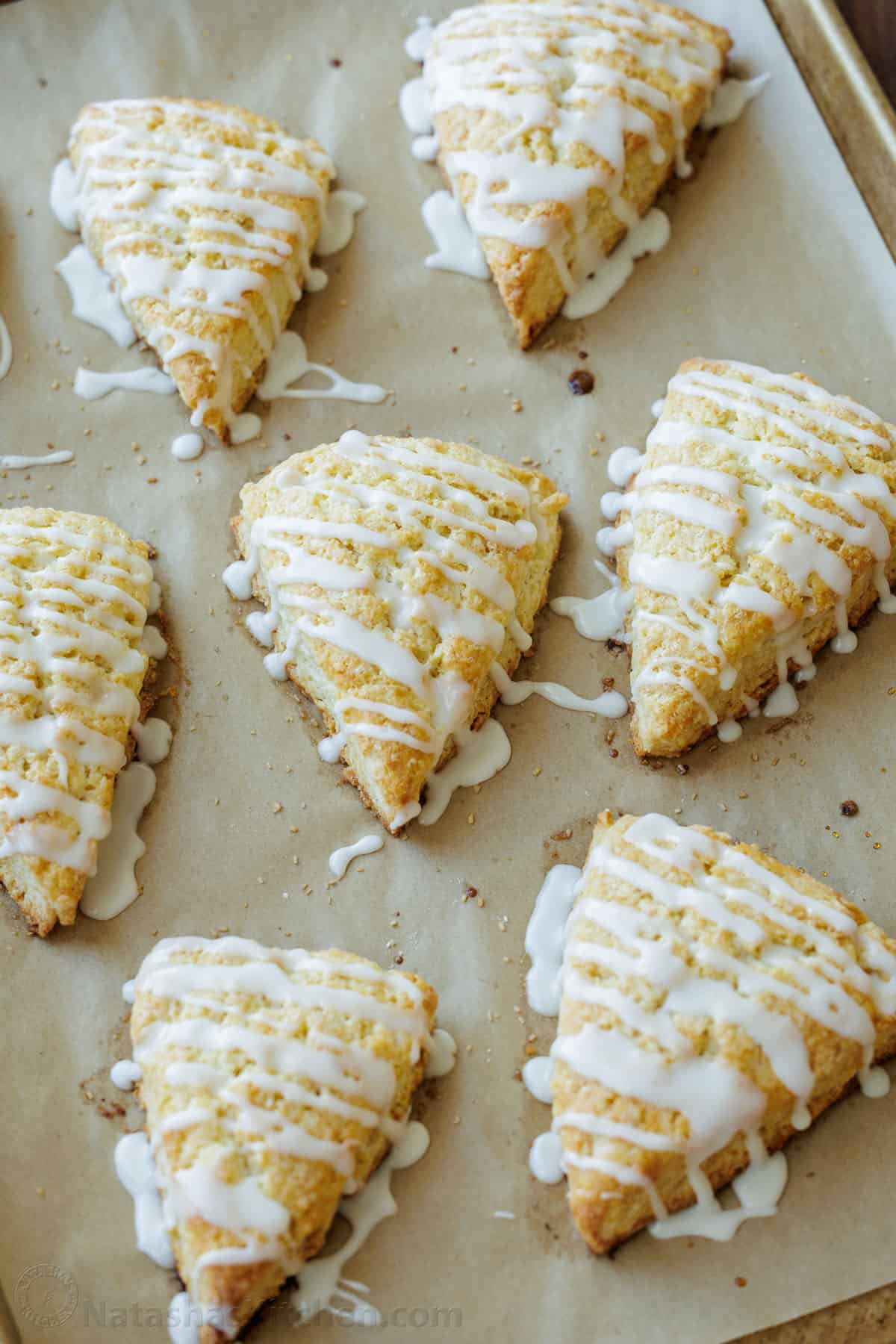
Pro Tip
The glaze will set and harden within an hour. If you are glazing ahead, cover and store the scones once the glaze sets.
What can I use instead of a pastry cutter?
If you don’t have a pastry cutter, there are several methods for cutting butter into flour. You can use two forks or knives, or a food processor. Alternatively, you can freeze the stick of butter and grate on the large holes of a box grater. The key is to use cold butter and not work the dough too much, creating overly dense scones.
What to Serve With Scones
We love to enjoy scones in the morning for breakfast or brunch. Scones go great with:
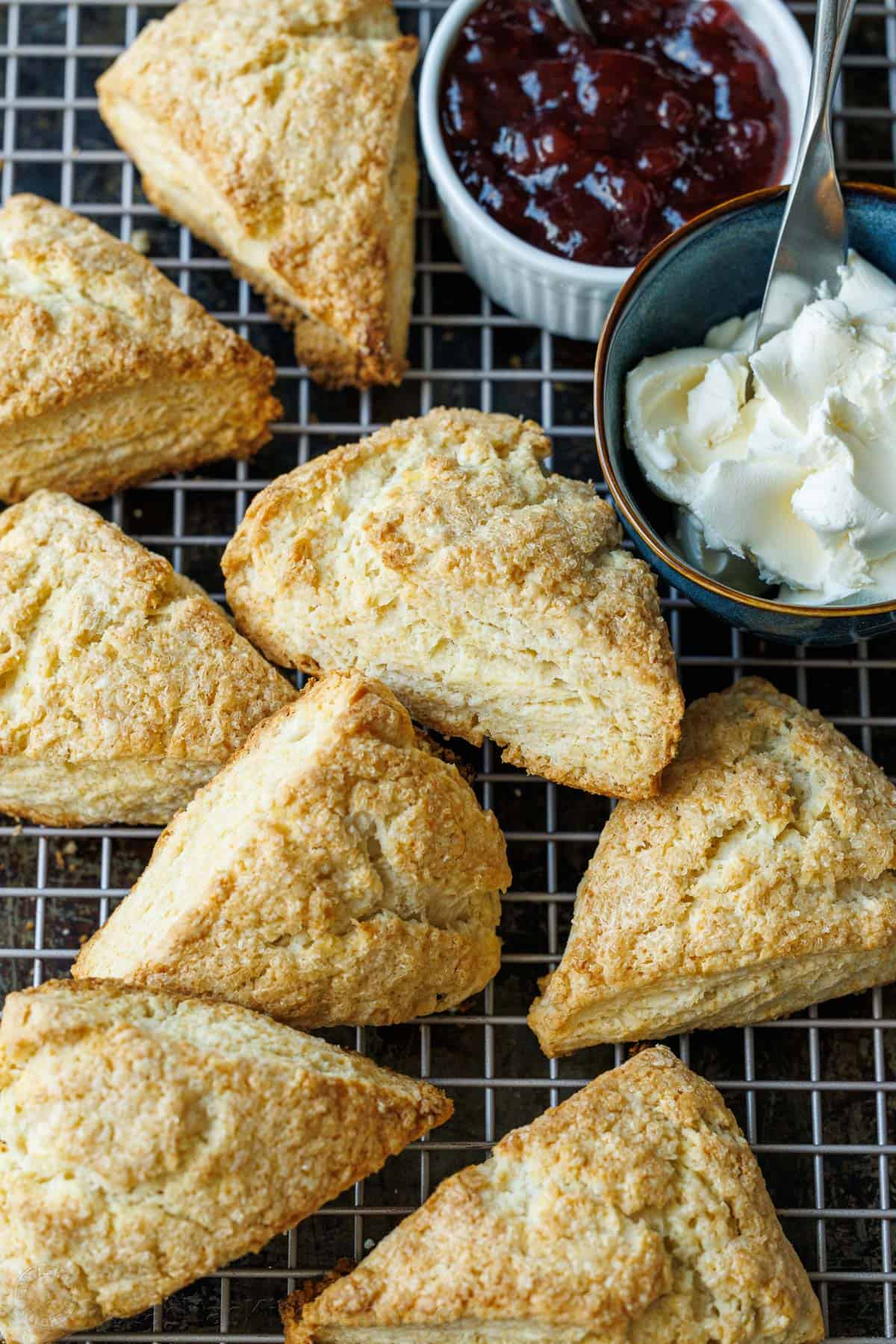
Make-Ahead Scones
Like most baked goods, scones taste best right out of the oven, still warm, but you can make them ahead and bake fresh the next morning.
- To bake in the morning: Follow steps 1-5 to prepare your scones, then cover and refrigerate the unbaked scones overnight. Bake them chilled, directly from the refrigerator.
- Storing baked scones: Transfer cooled scones to an airtight container for up to 3 days (or 5 days in the refrigerator).
- Freezing: You can freeze scones baked or unbaked.
- To freeze dough: Place your cut dough wedges onto a baking sheet and freeze for 1 hour. Transfer to a freezer-safe bag and freeze for up to 3 months. Thaw in the refrigerator overnight or bake from frozen, adding 2 minutes to the baking time.
- To freeze baked scones: After baking, cool on a wire rack. Transfer to an airtight container or freezer bag. Freeze for up to 3 months.
- To reheat: microwave for 20 seconds or place in the oven at 300°F for 10 minutes.
This deliciously moist and flaky Scones Recipe is the base for a variety of perfect, homemade scones. Once you know how to make classic scones, you can come up with a hundred flavor variations.
We love homemade pastry recipes from our classic Apple Turnovers to the famous Baklava. If you’re also a fan of delicious pastries, this classic Scone recipe is a must-try!

Best Scone Recipe
Scones can be served for breakfast or brunch, at an elegant afternoon tea (bridal or baby showers come to mind), or at a cozy gathering with family or friends. With so many flavor options- from blueberries, chocolate chips, or lemon zest- they are a perfect treat. Here’s why you’ll love this scone recipe:
- Customizable – It can be easily made with your favorite ingredients to suit your taste.
- Make-Ahead – The recipe can be made ahead of time and frozen (see instructions below).
- Texture perfection – Moist inside with a touch of crisp on the outside.
What are Scones?
Scones originated in the United Kingdom. They are considered a quick bread, often shaped into circles similar to a Southern biscuit, or wedges. Though they have similar ingredients as biscuits – a foundation of flour, butter, heavy cream (or buttermilk), and a leavening agent to help them rise – the proportions and resulting textures are completely different.
English “scones” are closely related to American “Biscuits” – they are less sweet and are served with Devonshire cream or clotted cream and jam. American scone recipes like this one, tend to have more butter, heavy cream, and sugar in the recipe and often have mix-ins added.

Tips for Making the Best Scones
The key to making fluffy and flaky scones is to use cold ingredients and keep them cold. If you use room-temperature ingredients or handle the dough too much, your dough will over-spread in the oven, leaving you with flat scones instead of the tall, moist, and flaky scones you dream about.
- Cold Ingredients – Keep all of your ingredients refrigerated and very cold until ready to use.
- Dice butter ahead of time and then return it to the refrigerator until it is time to add it to the recipe.
- Chill before baking – Refrigerate your formed dough for at least 15 minutes before baking.
- Cut straight down with a food scraper or knife and avoid using a sawing motion.
- Fully preheat the oven – a hot oven turns the butter into steamy air pockets and prevents butter from pooling in the pan. An oven thermometer helps!
Ingredients for Scones
See the list below (full measurements in the recipe card) for my tried and true scone recipe.
- Flour – All-purpose works great
- Sugar – lightly sweetens the dough
- Baking powder – makes the dough rise
- Salt – balances the flavors
- Butter – unsalted (make sure it’s cold)
- Egg – adds structure and flavor
- Heavy cream – cold cream provides moisture for a rich texture and soft crumb; also used to brush the tops
- Vanilla extract – try real or homemade vanilla for the best flavor
- Raw sugar – to sprinkle over scones

Optional Vanilla Glaze
- Milk – any kind, even a dairy-free milk. Add more milk to thin the glaze.
- Powdered sugar – Add more powdered sugar to thicken the glaze.
- Vanilla – Use real vanilla extract

Variations
We recommend adding 1 to 1 1/4 cups of add-ins. Adding too much fruit may cause your scones to fall apart. We recommend the following varieties, but get creative and add in your favorites!
- Blueberry Scones
- Chocolate Chip Scones – Use mini chocolate chips
- Raspberry and White Chocolate Chip Scones
- Blackberry Scones
- Cranberry Orange Scones
- Strawberry Scones
- Cinnamon Sugar Scones – sprinkle with 1 Tbsp sugar and 1/2 tsp cinnamon before baking.
- Savory Scones – Reduce your sugar to 2 Tbsp and omit vanilla. Add 1 cup of shredded cheese (cheddar or parmesan), herbs (rosemary, thyme, chives), and cooked, bite-sized pieces of meat such as bacon or ham.

How to Make the Perfect Scones
- Prep – Preheat the oven to 400°F and line a baking sheet with parchment paper.
- Dry Ingredients – In a large mixing bowl, whisk together flour, sugar, baking powder and salt. Add cold unsalted butter and cut it into the flour mixture with a pastry blender until pea-sized crumbs form. Gently fold in flavor add-ins if using. Refrigerate while preparing wet ingredients.
- Wet Ingredients – In a small bowl, combine cream, eggs, and vanilla. Beat with a fork until well blended. Combine the cream mixture and flour mixture and fold with a spatula until moistened.
- Work the Dough – Transfer the dough onto a clean, lightly floured surface and work it into a ball of dough just until it comes together. Next, flatten into a 1-inch thick and 7-inch wide disk. Chop into 8 equal wedges.
- Chill – Arrange scones on a lined baking sheet 1 inch apart. Brush the tops with cream and generously sprinkle with coarse sugar. Refrigerate for 15 minutes before baking.
- Bake – Bake for 20-23 minutes. Remove from the oven and cool completely. Drizzle with glaze if desired.

Pro Tip:
The scones are done when the tops are golden and the edges golden brown. The internal temperature on an instant-read thermometer should register at 200°F when done.
How to Make Vanilla Glaze
In a small bowl, combine powdered sugar, milk, and vanilla. Stir until well blended. The glaze should be drizzling consistency; add powdered sugar to thicken or milk to thin the glaze. Using a spoon, drizzle the glaze over the cooled scones.

Pro Tip
The glaze will set and harden within an hour. If you are glazing ahead, cover and store the scones once the glaze sets.
What can I use instead of a pastry cutter?
If you don’t have a pastry cutter, there are several methods for cutting butter into flour. You can use two forks or knives, or a food processor. Alternatively, you can freeze the stick of butter and grate on the large holes of a box grater. The key is to use cold butter and not work the dough too much, creating overly dense scones.
What to Serve With Scones
We love to enjoy scones in the morning for breakfast or brunch. Scones go great with:

Make-Ahead Scones
Like most baked goods, scones taste best right out of the oven, still warm, but you can make them ahead and bake fresh the next morning.
- To bake in the morning: Follow steps 1-5 to prepare your scones, then cover and refrigerate the unbaked scones overnight. Bake them chilled, directly from the refrigerator.
- Storing baked scones: Transfer cooled scones to an airtight container for up to 3 days (or 5 days in the refrigerator).
- Freezing: You can freeze scones baked or unbaked.
- To freeze dough: Place your cut dough wedges onto a baking sheet and freeze for 1 hour. Transfer to a freezer-safe bag and freeze for up to 3 months. Thaw in the refrigerator overnight or bake from frozen, adding 2 minutes to the baking time.
- To freeze baked scones: After baking, cool on a wire rack. Transfer to an airtight container or freezer bag. Freeze for up to 3 months.
- To reheat: microwave for 20 seconds or place in the oven at 300°F for 10 minutes.
How to Make Scones
- Preheat the oven to 400°F and line a baking sheet with parchment paper.
- In a large mixing bowl, whisk together flour, sugar, baking powder, and salt. Add diced cold butter and cut it into the flour mixture using a pastry cutter until pea-sized butter crumbs form. Gently stir in flavor add-ins if using. Refrigerate the mixture while preparing liquid ingredients.

